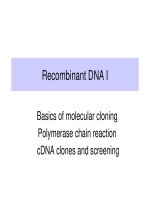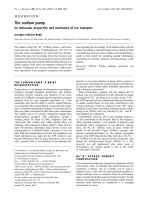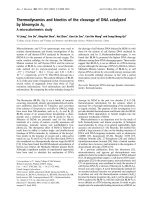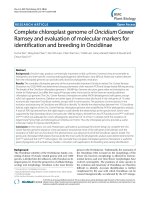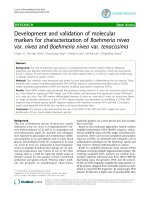Thermodynamics and mechanics of molecular motors
Bạn đang xem bản rút gọn của tài liệu. Xem và tải ngay bản đầy đủ của tài liệu tại đây (4.65 MB, 169 trang )
THERMODYNAMICS AND MECHANICS OF MOLECULAR
MOTORS
HOU RUIZHENG
(Bachelor of Science, Xi’an Jiaotong University)
A THESIS SUBMITTED
FOR THE DEGREE OF DOCTOR OF PHILOSIOPHY
DEPARTMENT OF PHYSICS
NATIONAL UNIVERSITY OF SINGAPORE
2013
DECLARATION
I hereby declare that this thesis is my original work and it has been written by me in its
entirety. I have duly acknowledged all the sources of information which have been used in
the thesis.
This thesis has also not been submitted for any degree in any university previously.
_________________
Hou Ruizheng
JANUARY, 2013
i
Acknowledgements
First and foremost, I would like to express my sincere gratitude to my supervisor
Professor Wang Zhisong. Communications with him not only inspired me greatly in the
academic aspect, but also led me to a profound thinking of my life. His advice will
always motivate me in the future.
Previous and current group members in the molecular motor lab gave me significant
support. In particular, I would like to thank Artem Efremov for discussions on
thermodynamics and kinetics, and Ren Jie for discussions on kinetic methods; I would
like to thank Cheng Juan, Loh Iongying, Sarangapani Sreelatha and Liu Meihan for
discussions on DNA motors and exchanging experiences of academic writing.
Many thanks to Professor Li Baowen for providing computational resources and other
resources for my studies. I would like to thank Professor Bao Weizhu and Wang Nan for
our collaborations on the worm-like-chain model, and Professor Zhang Chun and Zhou
Miao for our collaboration on an artificial molecular motor. Students and staffs in CCSE
gave me great help in academic aspect and in daily life. In particular, I would like to
thank Tao Lin, Zhu Feng, Qin Chu, Zhu Guimei, Liu Sha, Tang Qinglin, Yang Lina,
Feng Ling, Zhao Qifang and Balázs Szekeres; thanks to Wang Hailong for comments on
the thesis.
Last but not least, I am grateful to my parents for their support and encouragement.
ii
iii
Contents
Acknowledgements i
Contents iii
Summary ix
List of Publications xi
List of Figures xii
Chapter 1: Introduction ………………………………………………………… 1
1.1 The physics perspective of molecular motors ……………………… 1
1.2 Bio-motors: kinesin-1 and F1-ATPase as examples ………………… 3
1.2.1 kinesin-1 ………………………………………………… … 3
1.2.2 F1-ATPase …………………………………………………… 6
1.3 Status quo of artificial molecular motors ……………………………. 7
1.4 Theories of molecular motors ……………………………………… 9
1.4.1 Brownian motor theory ……………………………………… 9
1.4.2 Cycle kinetics and thermodynamics ………………………… 11
1.4.3 Mechanics of molecular motors ………………………………. 12
1.5 Scientific questions and objectives of the thesis ……………………. 13
Chapter 2: Energy price of microscopic direction …………………………… 16
2.1 Introduction …………………………………………………………. 16
2.2 Definition of directionality based on cycle kinetics ………… …… 17
iv
2.3 Least energy price for directionality ……………………………… 19
2.4 Thought experiments on the least energy price …………………… 22
2.5 Experimental verification of the least energy price ………………… 24
2.6 Macroscopic situations and consistency with thermodynamics laws 26
2.7 Conclusions …………………………………………………… … 27
Chapter 3: Best efficiency of isothermal molecular motors ……………………. 29
3.1 Introduction …………………………………………………………. 29
3.2 Motor’s efficiency and the least energy price for microscopic direction 30
3.3 Experimental phenomenology of kinesin-1 and F1-ATPase reveals 31
a best efficiency.
3.4 Thermodynamics of molecular motors represented by cycle kinetics 34
3.5 Optimal thermodynamics underlying the F1-ATPase and kinesin-1 38
phenomenology
3.6 Conclusions …………………………………………………………. 43
Chapter 4: Generalized efficiency at maximum power ……………….……… 45
4.1 Introduction ……………………………………… ……………… 45
4.2 Generalized efficiency and efficiency-velocity trade-off ………… 46
4.2.1 Definition of generalized efficiency ………………………… 46
4.2.2 The basic kinetic diagram …………………………………… 47
4.2.3 Generalized power ……………………………………………. 49
4.2.4 Efficiency-velocity trade-off ………………………………… 50
4.3 Generalized efficiency at maximum generalized power …………… 52
4.3.1 Equation of GEMP ……………………………………………. 52
4.3.2 Two upper limits of GEMP …………………………………… 53
v
4.3.3 Analytical solution at the limits ……………………….…… 54
4.3.4 Energy input constrains GEMP ………………………………. 55
4.3.5 Temperature dependence of GEMP ………………………… 57
4.3.6 Generalized efficiency and power at a finite load …………… 57
4.4 Discussions …………………………………………………………. 59
4.4.1 The concept of generalized efficiency ……………………… 59
4.4.2 GEMP and conventional EMP ……………………………… 61
4.4.3 Kinetic asymmetry ……………… …………………… … 61
4.5 Conclusions ……………………………………… ……………… 62
Chapter 5: Mechanics of Kar3/Vik1: a molecular fishing effect ………………. 64
5.1 Introduction …………………………………………………………. 64
5.2 Methods …………………………………………………………… 67
5.2.1 Mechanical model for MT-bound states of Kar3/Vik1heterodimer 67
5.2.2 Minimization of total free energy …………………………… 71
5.2.3 Mechanical properties of Kar3/Vik1 necks ………………… 72
5.3 Results ………………………………………………………………. 74
5.3.1 Stability of microtubule-bound states of Kar3/Vik1 ………… 74
5.3.2 A molecular “fishing” effect driven by ATP binding ………… 75
5.3.3 Kinesin-MT binding interface is evolved to better resist …… 77
destabilizing torque
5.3.4 The fishing force promotes MT depolymerization ………… 80
5.3.5 Asymmetry of fishing-promoted depolymerization ………… 81
5.3.6 Inter-head strain and neck structural changes in ……………… 83
Kar3/Vik1-MT binding
5.4 Discussions …………………………………………………………. 87
vi
5.4.1 Chemomechanical cycle for Kar3/Vik1 motility based on …… 87
the ATP-driven fishing effect
5.4.2 Chemomechanical coupling ratio of fishing-based motility … 88
5.4.3 The fishing promotes MT deploymerization by ……………… 89
a mechanochemical effect
5.4.4 The fishing is a new mechanism for head-head coordination …. 89
5.5 Conclusions …………………………………………………………. 90
Chapter 6: Proposal for an artificial nano-motor: implementation of fishing …. 92
mechanism
6.1 Introduction …………………………………………………………. 92
6.2 Methods …………………………………………………………… 93
6.2.1 Basic design of the motor track system ………………………. 93
6.2.2 Two methods for the motor’s operation ………………………. 95
6.2.3 Mechanical model …………………………………………… 96
6.2.4 Kinetic model …………………………………………………. 97
6.3 Results …………………………………………………………… 100
6.3.1 Minimal compound foot for track binding …………………… 100
6.3.2 Position-selective detachment ……………………………… 101
6.3.3 Two versions of the motor …………………………………… 102
6.3.4 Bias for forward binding …………………………………… 103
6.3.5 The main working cycle of the motor ……………………… 103
6.3.6 Motor performance ………………………………………… 104
6.3.7 Mechanistic integration and relation to motor performance …. 109
6.4 Discussions ………………………………………………………… 111
vii
6.4.1 The forward bias is a power Stroke ………………………… 111
6.4.2 The position-selective detachment is a molecular ratchet …… 112
6.4.3 Similarity to biomotor kinesin ……………………………… 112
6.4.4 Molecular fishing and similarity to biomotor Kar3/Vik1 ……. 113
6.5 Conclusions ………………………………………………………… 114
Chapter 7: Optimization of the proposed artificial motor ………………… 117
7.1 Introduction ………………………………………………………… 117
7.2 Methods …………………………………………………………… 118
7.2.1 Motor-track system ………………………………………… 118
7.2.2 Mechanical model and kinetic model for the motor …………. 120
under an external load
7.2.3 Two-step optimization ……………………………………… 120
7.3 Results and discussions …………………………………………… 121
7.3.1 Three previous predictions of nanomotor thermodynamics …. 121
and optimality
7.3.2 A single predominant cycle ………………………………… 122
7.3.3 Entropy-directionality relation ……………………………… 123
7.3.4 Motor optimality …………………………………………… 126
7.3.5 Speed-directionality tradeoff ………………………………… 130
7.3.6 Entropy crisis ………………………………………………… 130
7.3.7 Load dependence of operational rates for motors of universal 132
optimality
7.4 Conclusions ………………………………………………………… 132
Chapter 8: Conclusions and perspectives ………………………………………. 135
viii
Bibliography ……………………………………………………………………… 139
ix
Summary
A molecular motor is composed of a single molecule or several molecules, yet is able to
move directionally in an isothermal environment. To date several types of biomolecular
motors have been discovered from biology, and a few types of artificial motors have been
synthesized in laboratory. The science behind the biomolecular motors remains largely
unclear, and the artificial ones are still far poorer in performance than the biological
counterparts. This thesis studies thermodynamics and mechanics of molecular motors in
the hope of revealing their physical mechanisms.
In the thermodynamic study, the relation between a motor’ performance and energy
consumption is studied. A general kinetic representation of molecular motors is
introduced and the concept of entropy production is applied. The 2
nd
law of
thermodynamics sets an energy price for directional motion in an isothermal environment.
To quantify the direction of motion, a new quantity directionality is defined. The least
energy price for microscopic direction is derived. This theoretical prediction is proved by
experimental data of two bio-motors, kinesin-1 and F1-ATPase, for fuel-induced motion
and external force-induced motion. Based on the least energy price, a thermodynamic
theory of molecular motors is formulated. While the 2
nd
law of thermodynamics decides
the efficiency limit of macroscopic heat engine, it is unclear whether the 2
nd
law remains
a primary constraint on efficiency of molecular motors. Based on experimental data of
x
kinesin-1 and F1-ATPase, the efficiency limit of molecular motors is formulated and
directionality is identified as the key parameter to access the limit. Moreover, a
generalized efficiency is defined. Experimental data show that the generalized efficiency
is a load-independent constant for F1-ATPase and kinesin-1, which suggests its relevance
to molecular motors at any load. Thermodynamic limits of molecular motors based on
this quantity are studied. Kinesin-1 is found to work at generalized efficiency at
maximum generalized power, while F1-ATPase has an ideal efficiency-speed trade-off
that enables it to maintain ~ 100% efficiency and a workable speed simultaneously.
Mechanical study of two specific motor systems is conducted to explore their
molecular mechanisms. First, a molecular mechanical model for bio-motor Kar3/Vik1 is
constructed, and a molecular fishing mechanism is identified. Second, an artificial
molecular motor is designed to implement the fishing mechanism. Two complementary
effects, position-selective foot detachment and biased forward binding, emerge from the
motor’s intrinsic mechanics. Third, thermodynamics of the motor is systematically
optimized based on a mechanical modeling. The artificial motor’s directionality can be
optimized simultaneously for any load by adjusting the motor’s physical construction
regardless of external operation. A speed-directionality trade-off is found, which may be
attributed to an entropy crisis. All these results are consistent with the general
thermodynamics study above.
xi
List of Publications
Ruizheng Hou and Zhisong Wang (2010). "Coordinated molecular "fishing" in
heterodimeric kinesin." Physical Biology 7: 036003.
Juan Cheng, Sarangapani Sreelatha, Ruizheng Hou, Artem Efremov, Ruchuan Liu, Johan
R. C. van der Maarel, and Zhisong Wang (2012). "Bipedal Nanowalker by Pure Physical
Mechanisms." Physical Review Letters 109(23).
xii
List of Figures
1.1 Illustration of kinesin-1 walker. …………………… …………………… 4
1.2 Illustration of F1-ATPase inside F1Fo-ATP synthase. …………………… 6
2.1 Stochastic kinematics, transition representation and elemental cycles for an 18
arbitrary microscopic object in a directional motion inside an isothermal
environment.
2.2 Directional motion of a microscopic object induced by a constant pulling force 22
or equivalently a field of constant slope in an isothermal environment.
2.3 The energy-direction equality versus experiments of biomolecular motors … 25
kinesin (a bipedal walker) and F1-ATPase (a rotor).
3.1 Characters of biological nanomotors kinesin and F1-ATPase: ………….…… 32
work and energy for direction.
3.2 Characters of biological nanomotors kinesin and F1-ATPase: directionality. 33
3.3 Generic transition diagram and its implementation by biological nanomotors 35
kinesin and F1-ATPase.
3.4 Maximal rate by which energy is channelled into direction for …………… 42
F1-ATPase and kinesin.
4.1. Generalized efficiency of biological molecular motors kinesin and F1-ATPase. 46
xiii
4.2 Generic kinetic diagrams and its implementation by biological nanomotors …. 48
kinesin and F1-ATPase.
4.3 Generalized efficiency and generalized power of molecular motors. ………… 51
4.4 Maximum power and corresponding generalized efficiency versus …………. 56
energy input and temperature.
4.5 Generalized power versus generalized efficiency of kinesin and F1-ATPase … 58
at different loads.
5.1 Mechanics and energies of Kar3/Vik1. ………………………………………. 66
5.2 Molecular fishing effect. ……………………………………………………… 70
5.3 Torques caused by the fishing effect. ………………………………………… 79
5.4 Fishing forces and torques under external load. ……………………………… 82
5.5 Inter-head strain and neck structural changes in Kar3/Vik1-MT binding. …… 84
5.6 Motility based on ATP-driven fishing. ……………………………………… 86
6.1 Bipedal walker and its mechanics. ……………………………………………. 94
6.2 Kinetic model of the motor. ………………………………………………… 98
6.3 Performance of the motor operated by alternate shortening-lengthening ……. 105
of the neck linker: dependence on foot-track binding.
6.4 Performance of the motor operated by alternate shortening-lengthening ……. 106
of the neck linker: dependence on operational rates.
xiv
6.5 Performance of the motor operated by alternate shortening-lengthening ……. 108
of the ankle chains: dependence on foot-track binding.
6.6 Performance of the motor operated by alternate shortening-lengthening ……. 109
of the ankle chains: dependence on operational rates.
6.7 Motor defect in position-selective detachment. ……………………………… 111
7.1 Motor and single predominant working cycle. ………………………………. 119
7.2 Entropy-directionality relation: varying operational rates. ………………… 124
7.3 Entropy-directionality relation: varying size/mechanics of the motor. ……… 125
7.4 Entropy-directionality relation: alternative operation. ……………………… 126
7.5 Motor optimality. …………………………………………………………… 127
7.6 Speed-directionality tradeoff and entropy crisis. …………………………… 129
1
Chapter 1
Introduction
1.1 The physics perspective on molecular motors
A molecular motor is usually composed of a single molecule or several molecules and
performs directional motion. Molecular motor research is a relatively new field. The very
early interest in a motor of an extremely small size can be traced back to 1959, when
physicist R. P. Feynman gave a talk titled “There’s Plenty of Room at the Bottom” at the
annual meeting of the American Physical Society. In his talk, he raised a question closely
related to molecular motors: “What are the possibilities of small but movable machines?”
Roughly at the same period, a molecular motor called myosin was discovered in muscle
organisms, which provided a molecular basis for muscle contraction [1-7]. Since then a
long list of molecular motors has been identified from biology. Besides, molecular
motors are potentially important to the emerging nanotechnology, and a lot of efforts
have been made to fabricate artificial molecular motors in laboratory. To date a few types
of artificial molecular motors have been successfully synthesized, though their
performance is still far poorer than that of biological counter-parts, which have already
existed for millions of years.
2
A top priority of molecular motors research is to understand their physical
mechanisms. The history of steam engine seems to offer a parallel to molecular motor
research today. The most important improvement of steam engine came in late 18
th
century in Scotland when James Watt introduced a separated chamber apart from piston
to condense steam, which promoted the engine’s efficiency for heat-to-work conversion.
After Watt, a Frenchman Sadi Carnot started to seek limit of heat engines. He proposed a
general and idealized model of heat engines, which is known as Carnot’s cycle today. He
found that the best possible efficiency of heat engines was limited by temperature of the
two reservoirs between which it is operated, namely η = 1−T
1
/T
2
[8]. The Carnot’s limit is
closely related to the nature of heat, and later led to the 2
nd
law of thermodynamics at the
hand of Clausius and Kelvin.
Likely, thermodynamics is also crucial in deciding the working mechanisms and
performance of molecular motors, although their small size normally renders an
immediate environment of uniform temperature and relatively strong thermal fluctuations.
The 2
nd
law of thermodynamics requires that in an isothermal environment any sustained
directional motion must dissipate energy and increase the overall entropy. Identifying
thermodynamic limits for directional motion of molecular motors is a main part of this
thesis. For this purpose, analyses on experimental data of high-performing biological
motors and theoretical formulation are especially necessary. Below we will review
experimental and theoretical studies of molecular motors from biology as well as man-
made nanotechnology.
3
1.2 Bio-motors: kinesin-1 and F1-ATPase as examples
Since the discovery of muscle myosin, several types of biological motors have been
identified [9, 10], including myosin derivatives [11-13], kinesin [14], dynein [15-17],
FoF1-ATP synthase [18] and helicase etc. Today, each type represents a big group of
proteins, which are further calssified into multiple protein families (e.g. kinesin have 14
families [19], from kinesin-1 to kinesin-14). Among these motors, myosin, kinesin and
dynein are bipedal walkers, and cytoskeletons serve as their tracks [6]; they are
responsible for intracellular vesicle transport [20, 21] and for dynamic control of
cytoskeleton [22] during muscle contraction [6], cell division [23-25] and cell migration.
FoF1-ATP synthase is a rotor synthesizing ATP molecules which are the common energy
source for most of biological processes. F1-ATPase is a part of FoF1-ATP synthase,
which interacts with ATP. Helicase mainly interacts with DNA and manipulates DNA.
Experiments demonstrate a superior performance of kinesin-1 and F1-ATPase, thus they
are chosen as the targets of thermodynamic analysis in this thesis. Details of the two
motors are discussed below.
1.2.1 Kinesin-1
In 1985, the first member of kinesin families was discovered in squid, which is kinesin-1
[14]. From then on, kinesin-1 becomes a target of intensive research because it is the
smallest biped discovered in biology, yet capable of impressive performance. Under
physiological condition, it moves about 100 steps (each step is ~ 8 nm [26]) in one
second along its track [27-30]. When attaching to a track, it moves persistently over a
4
distance about 1 μm (~ 100 steps) before it derails from the track [31]. When moving, it
resists a force as large as 7 pN [27-29], and its maximum energy efficiency is about 60 ~
70 % (the energy input for one step is about 20 ~ 23 k
B
T). Kinesin-1 maintains nearly a
single direction during its movement when no load is attached: only 1 backward step in
1000 forward steps on average [28] (forward direction refers to minus end of the track).
Such outstanding performance must be produced by superior working mechanisms.
5
Figure 1.1 Illustration of kinesin-1 walker. The bipedal walker is kinesin-1, composed of two heads (red
balls) and a necklinker (blue chain). The tubule-shaped track is microtubule (only a small length of
microtubule is shown), composed of 13 tubulin filaments. α and β denote the two basic units (α-tubulin &
β-tubulin) which compose a tubulin filament by self-assembly. Microtubule is asymmetric. ‘+’ and ‘−’
denote the plus end and minus end of the track. ATP is the fuel molecule supplying energy to the walking
of kinesin-1; ADP and Pi are the waste after fuel is consumed.
Kinesin-1 is a bipedal walker which is dimerized by two identical protein monomers
(Fig. 1.1). The two heads of the motor, which are similar to the two feet of man, are
connected by two soft peptide chains called neck-linkers. Kinein-1 moves along its track
(microtubule) in a hand-over-hand fashion, just like man’s walk [32]. Both of the heads
are able to hydrolyze ATP [33] to supply energy for the motion. However, the two heads
do not hydrolyze ATP independently, but act cooperatively with each other [34, 35].
Specifically, when only one head attaches to the track, the other free head always moves
toward the forward direction (plus end of microtubule) and binds to the track. The
binding bias is induced by a so called zippering effect, powered by the binding of ATP to
the attached head [36, 37]. When both heads attach to the track, the rear head always
detaches from the track first, powered by the energy from phosphate (Pi) release. The
detaching bias is induced by an ATP-gating mechanism [38, 39]. The cooperation
between the two heads realizes a highly ordered pattern of energy consumption, and
further leads to the good performance of kinesin-1, especially the single direction of
motion. The relation between the motor’s performance and its energy consumption
during the working processes is relevant to the thermodynamics of kinesin-1. Moreover, a
lot of experimental data about performance of kinesin-1 have been reported [27-29, 40-
44], which are good materials for theoretical analysis.
6
1.2.2 F1-ATPase
Figure 1.2 Illustration of F1-ATPase inside F1Fo-ATP synthase. F1Fo-ATP synthase is composed of a
stator (red, ab
2
α
3
β
3
δ), and a rotor (blue, c-ring γε) which is usually inside membrane (yellow). The rotor
will rotate while the units of α
3
β
3
are hydrolyzing ATP. F1-ATPase refers to the units of α
3
β
3
γ.
F1Fo-ATP synthase is the enzyme that manufactures ATP from ADP and Pi using the
energy stored in a transmembrane ion gradient. ATP molecules are fuels for most of
biological processes, thus F1Fo-ATP synthase is a vital device for life. It is composed of
a stator and a rotor, which are made of many protein units (Fig. 1.2). When an ion flow
goes across the membrane through a unit (Fig. 1.2), the rotor is driven to rotate towards
one direction, and simultaneously ATP molecules are synthesized on the α
3
β
3
unit of the
stator, using the energy transmitted through the rotation of γ unite [18]. For one cycle of
7
rotation, about 12 ions will go across membrane and 3 ATP will be synthesized.
Conversely, when ATP is hydrolyzed on the stator, the whole process will be reversed
and the rotor will rotate in an opposite direction. In this thesis we only focused on a part
of the synthase, which is α
3
β
3
γ, known as F1-ATPase.
F1-ATPase is a rotary motor. When hydrolyzing ATP, γ unite will rotate directionally.
Experiments show an amazing efficiency of F1-ATPase (~ 100%), while the speed of the
rotor is not low [45-48]. How the motor realizes the good performance is puzzling.
Similar to kinesin-1, all the three β units hydrolyze ATP. However, when working the
three units do not hydrolyze ATP independently. In a cycle of rotation, 3 ATP molecules
will be hydrolyzed sequentially by the three β units. The energy in ATP is released in a
highly ordered pattern, which is achieved by the cooperation between the three β and the
three α units [48]. The highly ordered energy consumption probably contributes to the
high efficiency of F1-ATPase.
1.3 Status quo of artificial molecular motor research
Three types of artificial molecular motors, including shuttles, rotors and walkers, have
been fabricated in lab. The three types represent three basic styles of motion for machines:
linear shuttling, rotating and processive walking. At present, most of molecular shuttles
and rotors are fabricated from chemically synthesized molecules [49, 50], and their
motion is driven by either chemical reactions or light. The shuttles have at least two
different configurations, and each is associated with certain chemical or light at certain
frequency in the environment. The shuttles perform sustained shuttling motion while
